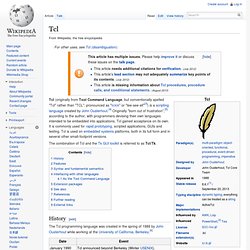

ActiveTcl is Tcl for Windows, Mac, Linux, AIX, HP-UX & Solaris. ActiveTcl Business and Enterprise Editions include our precompiled, supported, quality-assured Tcl distribution used by millions of developers around the world for easy Tcl installation and quality-assured code.

When you're using Tcl on production servers or mission-critical applications, ActiveTcl Business Edition and Enterprise Editions offer significant time savings over open source Tcl for installing, removing, upgrading, and managing common Tcl modules. Not sure which edition is right for you? Check out our Compare Editions chart. Tested, Timely and Compatible Save time in your development cycles by starting with a precompiled Tcl distribution for out-of-the-box installation and standardization across the operating systems you rely on, including Windows, Linux, Mac OS X, Solaris, AIX, and HP-UX.
ActiveTcl Business and Enterprise Editions includes: Business Edition licensing is for each production or external-facing server, including virtual servers. Support Options Free Email support** Tcl/Tk Tutorial - Create GUI using Tk with Tcl Language. Tcl/Tk - one language, many uses. It can be used for GUI(Graphical User Interface) development with the powerful TK. Tcl/Tk runs as a plugin from web browsers made by Netscape and Microsoft. So it can be used instead of JavaScript and VBScript. It is a CGI language and can be used in servers. Tcl-Tk is also extremely extendable - Tcl/Tk is valuable to C/C++ programmers who want to learn a high-level scripting language for their user interfaces or for integrating pieces of a large system.
Tcl stands for Tool Command Language. Tcl is a very simple, open-source-licensed programming language and provides basic language features such as variables, procedures, and control, and it runs on almost any modern OS, such as Unix, Macintosh, and Windows 95/98/NT/XP computers. Welcome to the Tclers Wiki! Tcl. Tcl (originally from Tool Command Language, but conventionally spelled "Tcl" rather than "TCL"; pronounced as "tickle" or "tee-see-ell"[3]) is a scripting language created by John Ousterhout.[4] Originally "born out of frustration",[5] according to the author, with programmers devising their own languages intended to be embedded into applications, Tcl gained acceptance on its own.

It is commonly used for rapid prototyping, scripted applications, GUIs and testing. Tcl is used on embedded systems platforms, both in its full form and in several other small-footprint versions. History[edit] The Tcl programming language was created in the spring of 1988 by John Ousterhout while working at the University of California, Berkeley.[6] Tcl conferences and workshops are held in both the United States and Europe. Features[edit] Tcl's features include Safe-Tcl is a subset of Tcl that has restricted features. Syntax and fundamental semantics[edit] A Tcl script consists of several command invocations.
Tcl Developer Site. Scripting Graphical Commands with Tcl/Tk Mini-HOWTO. Salvador J. Peralta One of the richest aspects of Linux is its abundance of commandline utilities. The ability to rapidly provide a graphical frontend for those utilities to make them available to non-technical users can be a handy skill for a developer or administrator to possess. This article provides a cookbook-style tutorial introduction to Tcl and Tk, a scripting language and graphical toolkit that were designed to accomplish that very task. Copyright (c) 2003 Salvador Peralta Permission is granted to copy, distribute and/or modify this document under the terms of the GNU Free Documentation License, Version 1.2 or any later version published by the Free Software Foundation; with no Invariant Sections, no Front-Cover Texts, and no Back-Cover Texts.
The tool command language Tcl (pronounced tickle) is an interpreted, action-oriented, string-based, command language. The previous example illustrates several aspects of the Tcl language. Let's break down these two lines of code: pack .submit. Online - The Linux Tcl and Tk HOWTO: What is Tcl/Tk.